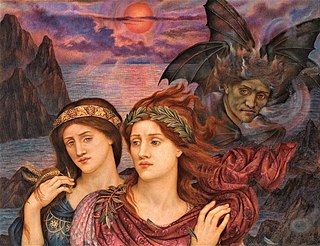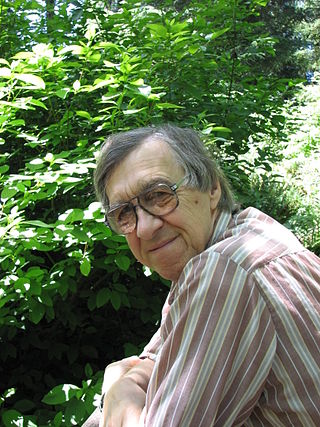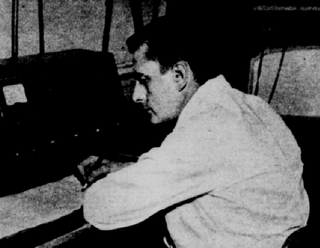Related Research Articles

Clairvoyance is the magical ability to gain information about an object, person, location, or physical event through extrasensory perception. Any person who is claimed to have such ability is said to be a clairvoyant.

Extrasensory perception or ESP, also called sixth sense, is a claimed paranormal ability pertaining to reception of information not gained through the recognized physical senses, but sensed with the mind. The term was adopted by Duke University psychologist J. B. Rhine to denote psychic abilities such as intuition, telepathy, psychometry, clairvoyance, clairaudience, clairsentience, empathy and their trans-temporal operation as precognition or retrocognition.

Parapsychology is the study of alleged psychic phenomena and other paranormal claims, for example, those related to near-death experiences, synchronicity, apparitional experiences, etc. Criticized as being a pseudoscience, the majority of mainstream scientists reject it. Parapsychology has also been criticised by mainstream critics for many of its practitioners claiming that their studies are plausible in spite of there being no convincing evidence for the existence of any psychic phenomena after more than a century of research.
Parapsychology is a field of research that studies a number of ostensible paranormal phenomena, including telepathy, precognition, clairvoyance, psychokinesis, near-death experiences, reincarnation, and apparitional experiences.

Telepathy is the purported vicarious transmission of information from one person's mind to another's without using any known human sensory channels or physical interaction. The term was first coined in 1882 by the classical scholar Frederic W. H. Myers, a founder of the Society for Psychical Research (SPR), and has remained more popular than the earlier expression thought-transference.

A psychic is a person who claims to use extrasensory perception (ESP) to identify information hidden from the normal senses, particularly involving telepathy or clairvoyance, or who performs acts that are apparently inexplicable by natural laws, such as psychokinesis or teleportation. Although many people believe in psychic abilities, the scientific consensus is that there is no proof of the existence of such powers, and describes the practice as pseudoscience. The word "psychic" is also used as an adjective to describe such abilities.

A ganzfeld experiment is an assessment used by parapsychologists that they contend can test for extrasensory perception (ESP) or telepathy. In these experiments, a "sender" attempts to mentally transmit an image to a "receiver" who is in a state of sensory deprivation. The receiver is normally asked to choose between a limited number of options for what the transmission was supposed to be and parapsychologists who propose that such telepathy is possible argue that rates of success above the expectation from randomness are evidence for ESP. Consistent, independent replication of ganzfeld experiments has not been achieved, and, in spite of strenuous arguments by parapsychologists to the contrary, there is no validated evidence accepted by the wider scientific community for the existence of any parapsychological phenomena. Ongoing parapsychology research using ganzfeld experiments has been criticized by independent reviewers as having the hallmarks of pseudoscience.

Daryl J. Bem is a social psychologist and professor emeritus at Cornell University. He is the originator of the self-perception theory of attitude formation and change. He has also researched psi phenomena, group decision making, handwriting analysis, sexual orientation, and personality theory and assessment.
Dean Radin investigates phenomena in parapsychology. Following a bachelor and master's degree in electrical engineering and a PhD in educational psychology Radin worked at Bell Labs, as a researcher at Princeton University and the University of Edinburgh, and was a faculty member at University of Nevada, Las Vegas. He then became Chief Scientist at the Institute of Noetic Sciences (IONS) in Petaluma, California, USA, later becoming the president of the Parapsychological Association. He is also co-editor-in-chief of the journal Explore: The Journal of Science and Healing. Radin's ideas and work have been criticized by scientists and philosophers skeptical of paranormal claims. The review of Radin's first book, The Conscious Universe, that appeared in Nature charged that Radin ignored the known hoaxes in the field, made statistical errors and ignored plausible non-paranormal explanations for parapsychological data.
Jessica Utts is a parapsychologist and statistics professor at the University of California, Irvine. She is known for her textbooks on statistics and her investigation into remote viewing.
Charles Henry Honorton was an American parapsychologist and was one of the leaders of a collegial group of researchers who were determined to apply established scientific research methods to the examination of what they called "anomalous information transfer" and other phenomena associated with the "mind/body problem"—the idea that mind might, at least in some respects, have a physical existence independent of the body.

Charles T. Tart is an American psychologist and parapsychologist known for his psychological work on the nature of consciousness, as one of the founders of the field of transpersonal psychology, and for his research in parapsychology.
Montague Ullman was a psychiatrist, psychoanalyst and parapsychologist who founded the Dream Laboratory at the Maimonides Medical Center in Brooklyn, New York and for over three decades promoted public interest in dreams and dream sharing groups.

Stanley Krippner is an American psychologist and parapsychologist. He received a B.S. degree from the University of Wisconsin–Madison in 1954 and M.A. (1957) and Ph.D. (1961) degrees from Northwestern University.
The Journal of Parapsychology is a biannual peer-reviewed academic journal covering research on psi phenomena, including telepathy, clairvoyance, precognition, and psychokinesis, as well as human consciousness in general and anomalous experiences.
Stephen E. Braude is an American philosopher and parapsychologist. He is a past president of the Parapsychological Association, Editor-in-Chief of the Journal of Scientific Exploration, and a professor of philosophy at the University of Maryland, Baltimore County.
Sensory leakage is a term used to refer to information that transferred to a person by conventional means during an experiment into ESP.

The Psychology of the Psychic is a skeptical analysis of some of the most publicized cases of parapsychological research by psychologists David Marks and Richard Kammann. The first edition, published in 1980, highlights some of the best-known cases from the 1970s. The second edition, published in 2000, adds information from the intervening 20 years as well as substantially more documentation and references to the original material.
Michael Anthony Thalbourne was an Australian psychologist who worked in the field of parapsychology. He was educated at the University of Adelaide and the University of Edinburgh. His books include: A glossary of terms used in parapsychology (2003), The common thread between ESP and PK (2004), and Parapsychology in the Twenty-First Century: Essays on the future of Psychical Research (2005).

Caroline Watt is a Scottish psychologist and professor of parapsychology. She is the holder of the Koestler Chair of Parapsychology at the University of Edinburgh. She is a past president of the Parapsychological Association. She is an author of several papers and books on parapsychology and runs an online course that helps educate the public about what parapsychology is and to think critically about paranormal claims.
References
- ↑ Michael A. Thalbourne; Lance Storm (December 23, 2004). Parapsychology in the Twenty-First Century: Essays on the Future of Psychical Research. McFarland. pp. 22–. ISBN 978-0-7864-1938-8.
- ↑ "Who is Deborah Delanoy?". Parapsychological Association.
- ↑ "The Centre for the Study of Anomalous Psychological Processes (CSAPP)". northampton.ac.uk. Archived from the original on 2013-11-16.
- ↑ "Researchers step into the twilight zone". Times Higher Education.